State Emblem of India
| State Emblem of India | |
|---|---|
 | |
| Details | |
| Armiger | Republic of India |
| Adopted | 26 January 1950 |
| Motto |
Satyameva Jayate ("Truth Alone Triumphs") |
The State Emblem of India, as the national emblem of India is called, is an adaptation of the Lion Capital of Ashoka at Sarnath, preserved in the Sarnath Museum near Varanasi, India. A representation of Lion Capital of Ashoka was initially adopted as the emblem of the Dominion of India in December 1947.[1] The current version of the emblem was officially adopted on 26 January 1950, the day that India became a republic.[2]
History
In 1947, as the date of independence for India and Pakistan approached, Jawaharlal Nehru gave charge of finding a suitable national emblem to Badruddin Tyabji, a civil servant, freedom fighter and member of the Constituent Assembly. Art schools all over the country were approached for designs, but none of them were found suitable as most were similar to the emblem of British Raj. Along with the Flag Committee headed by Dr. Rajendra Prasad, Tyabji and his wife suggested the use the Ashoka Capital, with four lions on top and the Ashoka Chakra flanked by a bull and horse below. Tyabji's wife Surayya Tyabji drew it and sent it to the printing press at Viceregal lodge for printing. This design was selected and has remained the emblem of the Indian government ever since.[3]
Usage and description
The emblem forms a part of the official letterhead of the Government of India and appears on all Indian currency as well. It also functions as the national emblem of India in many places and appears prominently on Indian passports. The Ashoka Chakra (wheel) on its base features in the centre of the national flag of India.
The usage of the emblem is regulated and restricted under State Emblem of India (Prohibition of Improper Use) Act, 2005. No individual or private organisation is permitted to use the emblem for official correspondence.
The actual Sarnath capital features four Asiatic lions standing back to back, symbolizing power, courage, confidence and pride, mounted on a circular base. At the bottom is a horse and a bull, and at its centre is a wheel (Dharma chakra). The abacus is girded with a frieze of sculptures in high relief of The Lion of the North, The Horse of the West, The Bull of the South and The Elephant of the East, separated by intervening wheels, over a lotus in full bloom, exemplifying the fountainhead of life and creative inspiration. Carved from a single block of sandstone, the polished capital is crowned by the Wheel of the Law (Dharma Chakra).
In the emblem finally adopted, only three lions are visible, the fourth being hidden from view. The wheel appears in relief in the centre of the abacus, with a bull on the right and a galloping horse on the left, and outlines of Dharma Chakras on the extreme right and left. The bell-shaped lotus beneath the abacus has been omitted.[4]
Forming an integral part of the emblem is the motto inscribed below the abacus in Devanagari script: Satyameva Jayate सत्यमेव जयते (English: Truth Alone Triumphs).[5] This is a quote from Mundaka Upanishad,[6] the concluding part of the sacred Hindu Vedas.
 The original Lion Capital of Ashoka
The original Lion Capital of Ashoka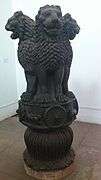 Ashoka Stambha at Indian Museum, Kolkata
Ashoka Stambha at Indian Museum, Kolkata Early photograph.
Early photograph.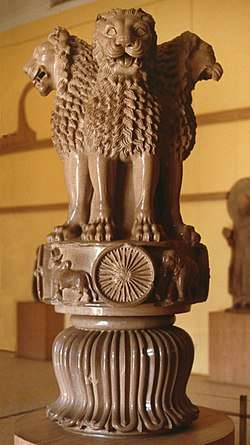 Photograph at time of discovery.
Photograph at time of discovery. Sarnath pillar capital of Ashoka.
Sarnath pillar capital of Ashoka.
Emblems of national bodies
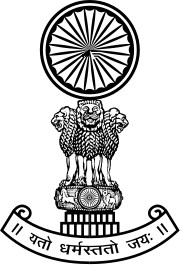 Emblem of the Supreme Court of India
Emblem of the Supreme Court of India Emblem of the Central Bureau of Investigation
Emblem of the Central Bureau of Investigation Emblem of the Research and Analysis Wing
Emblem of the Research and Analysis Wing
Historic seals and emblems
Pre-colonial India
 Seal of the Mughal Empire
Seal of the Mughal Empire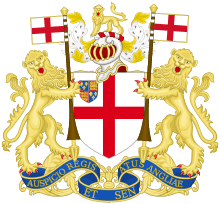 Coat of arms of the British East India Company which ruled most of the subcontinent after the Marathas until 1857
Coat of arms of the British East India Company which ruled most of the subcontinent after the Marathas until 1857
British rule in India
.svg.png) Coat of arms of the United Kingdom, used for official documents, publications and correspondence from the Parliament of the United Kingdom during the British Raj (1858-1947)
Coat of arms of the United Kingdom, used for official documents, publications and correspondence from the Parliament of the United Kingdom during the British Raj (1858-1947) Star of India, official emblem of British India used within India during the British Raj.
Star of India, official emblem of British India used within India during the British Raj.
Portuguese rule in India
.svg.png) Coat of arms of Portuguese India (1600-1935)
Coat of arms of Portuguese India (1600-1935) Lesser coat of arms of Portuguese India (1935-1961)
Lesser coat of arms of Portuguese India (1935-1961).svg.png) Greater coat of arms of Portuguese India (1935-1951)
Greater coat of arms of Portuguese India (1935-1951).svg.png) Greater coat of arms of Portuguese India (1951-1961)
Greater coat of arms of Portuguese India (1951-1961)
Dominion of India
.svg.png) Coat of arms of the United Kingdom used by the Dominion of India (August–December 1947)
Coat of arms of the United Kingdom used by the Dominion of India (August–December 1947)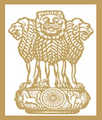 Emblem used by the Dominion of India (December 1947-January 1950) [1]
Emblem used by the Dominion of India (December 1947-January 1950) [1] Emblem of the Constituent Assembly of India
Emblem of the Constituent Assembly of India
See also
References
- 1 2 "Press Communique' - State Emblem" (PDF). Press Information Bureau of India - Archive. Archived (PDF) from the original on 8 August 2017.
- ↑ "State Emblem". Know India. Government of India. Archived from the original on 3 March 2016. Retrieved 1 May 2016.
- ↑ Tyabji, Laila (14 August 2018). "How the Tricolour and Lion Emblem Really Came to Be". The Wire. Retrieved 15 August 2018.
- ↑ "The State Emblem Of India (Prohibition Of Improper Use) Act, 2005" (PDF). 20 December 2005. p. 4. Archived from the original (PDF) on 19 March 2013. Retrieved 15 April 2012.
- ↑ Kamal Dey v. Union of India and State of West Bengal (Calcutta High Court 2011-07-14). Text
- ↑ "Rajya Sabha Parliamentary Standing Committee On Home Affairs: 116th Report on The State Emblem Of India (Prohibition Of Improper Use) Bill, 2004" (PDF). Archived from the original (PDF) on 8 March 2013.

